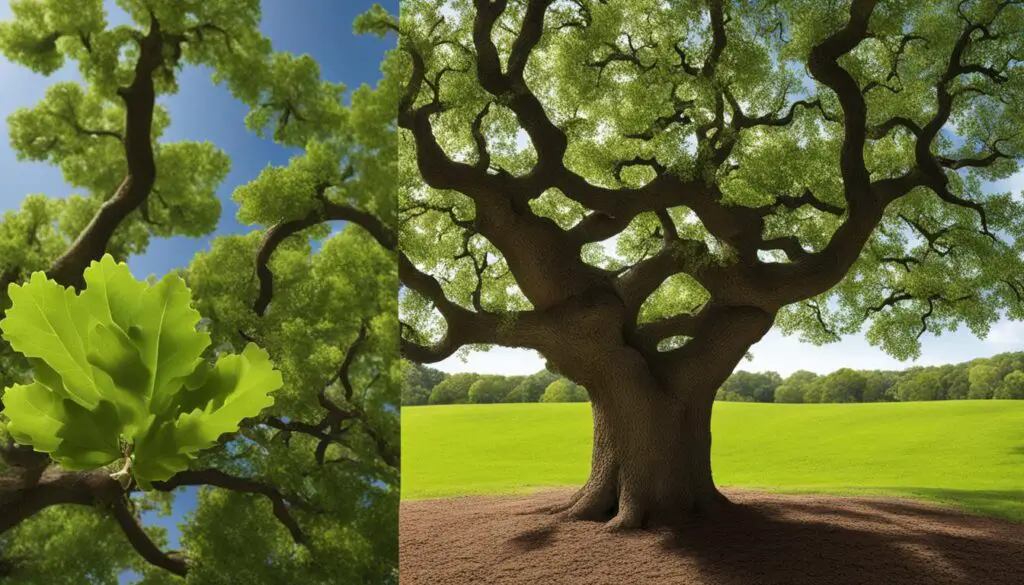Oak trees, with their strength and endurance, captivate our admiration. Understanding the timeline of their growth is vital to truly appreciate these majestic beings. Oak trees belong to the genus Quercus and encompass numerous species, each with its unique growth characteristics. Several factors influence their growth, such as environmental conditions, oak tree species, site conditions, and maintenance practices. Throughout their lifespan, oak trees progress through distinct stages, from germination and seedling to becoming a mature tree.
Key Takeaways:
- Oak trees possess remarkable strength and endurance.
- Various factors influence the growth of oak trees.
- Oak trees progress through stages including germination, seedling, young sapling, mature tree, and longevity.
Oak Tree Species and Characteristics
Oak trees are diverse, with over 600 species across the globe. Each oak species has its own growth rate and characteristics. Some species, like pin oaks, have faster growth rates and reach maturity within a few decades. Others, such as white oaks, have slower growth rates and may take several decades to mature.
Oak trees are known for their lobed or toothed leaves and recognizable acorns. The leaves of oak trees vary in shape, with some having deep lobes and jagged edges, while others have smoother leaf margins. These distinct leaf characteristics contribute to their visual appeal and help in identifying different oak species.
Here is a table showcasing some common oak tree species, their growth rates, and unique characteristics:
| Oak Tree Species | Growth Rate | Characteristics |
|---|---|---|
| Pin Oak | Fast | Pyramidal shape, deep green foliage, acorns with a fringed cap |
| White Oak | Slow | Large spreading canopy, rounded lobed leaves, sweet-tasting acorns |
| Red Oak | Moderate to fast | Tall and straight trunk, pointed lobed leaves, bitter acorns |
It’s important to note that these are just a few examples, and the world of oak tree species offers a vast array of growth rates and characteristics. Whether you prefer a fast-growing oak or one with slower growth, there is an oak species to suit your preferences and landscaping needs.
Factors Influencing Oak Tree Growth
The growth of oak trees is influenced by various factors that contribute to their overall health and development. Understanding these factors is key to ensuring optimal growth and maximizing the potential of these magnificent trees.
Environmental Conditions
Environmental conditions, such as climate, sunlight, water, and soil nutrients, have a significant impact on oak tree growth. Different oak species have specific preferences for temperature and soil types, which influence their ability to thrive and reach their full potential.
The Quality of the Planting Site
The quality of the planting site also plays a crucial role in oak tree growth. Soil fertility, drainage, and pH levels can greatly influence the tree’s ability to absorb water and nutrients. Providing the right conditions for root development and a healthy soil ecosystem is essential for long-term growth.
Proper Maintenance Practices
Implementing proper maintenance practices is vital for promoting healthy Oak tree growth. Regular watering, mulching, pruning, and pest control are important aspects of care that contribute to the tree’s overall health and resilience. These practices help maintain a favorable environment and protect against common issues that can hinder growth.
| Factors | Impact on Oak Tree Growth |
|---|---|
| Environmental Conditions | Climate, sunlight, water, and soil nutrients affect the overall health and growth of oak trees. |
| The Quality of the Planting Site | Soil fertility, drainage, and pH levels impact the tree’s ability to absorb water and nutrients. |
| Proper Maintenance Practices | Regular watering, mulching, pruning, and pest control contribute to the tree’s overall health and resilience. |

By considering these factors and providing the necessary environmental conditions and care, you can ensure that your oak trees thrive and reach their full growth potential. Whether you are cultivating oak trees in your backyard or managing them in a larger landscape, understanding and addressing these influences will contribute to the long-term success of these majestic trees.
Oak Tree Growth Stages
Oak trees go through distinct growth stages throughout their lifespan. Understanding these stages is essential for appreciating the magnificent journey of an oak tree’s life cycle.
The first stage of an oak tree’s growth is germination and seedling. It begins when an acorn, the fruit of the oak tree, develops into a tiny seedling. The acorn is planted in suitable soil conditions and given the necessary moisture and sunlight. Over time, the acorn transforms into a seedling, sprouting its first set of leaves. This stage marks the beginning of an oak tree’s journey.
Young Sapling Stage:
The second stage of growth is the young sapling stage. During this stage, the oak tree continues to establish its root system and grow taller and wider. The sapling develops a stronger and more extensive network of roots, enabling it to absorb nutrients and water from the soil. It gradually increases in height and girth, laying the foundation for future growth and strength.
Mature Tree Stage:
The third stage of growth is the mature tree stage. At this point, the oak tree has reached its full height and spread its branches widesp. It stands tall and sturdy, showcasing its majestic presence. In this stage, the oak tree is capable of producing acorns, the next generation of oak trees. The mature tree stage is a testament to the resilience and longevity of oak trees.
Oak trees are known for their ability to support ecosystems for several decades, and even centuries. They are an integral part of the natural world, providing shade, shelter, and habitat for numerous organisms. From germination to maturity, oak trees follow a remarkable growth journey that can be celebrated and admired.
Average Growth Time of Oak Trees
The growth time of oak trees can vary depending on various factors. On average, it takes oak trees about 20 to 50 years to reach maturity and achieve their full size. Some oak species may take longer, spanning several decades or even centuries to fully mature.
Oak trees are known for their slow growth rate, emphasizing the importance of patience and long-term nurturing. This slow growth highlights their resilience and ability to withstand various environmental conditions.
Understanding the average growth time of oak trees allows us to appreciate the time and effort it takes for these majestic beings to reach their full potential.
Factors Affecting Oak Tree Growth Rate
| Factors | Impact on Growth Rate |
|---|---|
| Environmental Conditions | Different species have preferences for temperature, sunlight, and soil types, influencing their growth. |
| Site Conditions | Quality of the planting site, including soil fertility, drainage, and pH levels, can impact oak tree growth. |
| Maintenance Practices | Proper watering, mulching, pruning, and pest control contribute to healthy growth. |
Care Tips for Promoting Oak Tree Growth
To promote healthy growth and ensure the longevity of oak trees, certain care practices are essential. Follow these tips to nurture your oak trees and help them thrive:
- Choose the Right Location: Plant oak trees in areas that receive ample sunlight and have well-draining soil. This will provide the necessary conditions for optimal growth.
- Regular Watering: Water your oak trees regularly, especially during dry spells or drought conditions. Ensure the soil is moist but not waterlogged, as excessive moisture can lead to root rot.
- Mulching: Apply a layer of organic mulch around the base of the oak tree to help retain soil moisture and regulate soil temperature. Mulch also prevents weed growth and adds nutrients to the soil as it decomposes.
- Adequate Space for Root Expansion: Give your oak trees enough space to allow their roots to expand freely. Avoid planting them too close to structures or other plants, as this can restrict root growth and cause competition for resources.
- Pruning: Regularly prune dead or damaged branches to promote healthy growth and maintain the tree’s structure. Pruning also enhances air circulation and reduces the risk of disease or pest infestations.
- Pest and Disease Control: Monitor your oak trees for any signs of pests or diseases. Take appropriate measures to control and treat these issues promptly to prevent them from affecting the tree’s growth and overall health.
- Fertilization: Consider fertilizing your oak trees to provide them with essential nutrients. Consult with a local arborist or horticulturist to determine the appropriate fertilizer type and schedule for your specific oak tree species.
- Protection from Construction or Landscaping Damage: Take precautions to protect your oak trees from potential damage during construction or landscaping activities. Avoid compacting the soil around the base of the tree or causing injury to the roots or trunk.
Example Oak Tree Care Schedule:
| Season | Care Tasks |
|---|---|
| Spring | Monitor for pests and diseases; prune dead or damaged branches; apply organic mulch. |
| Summer | Provide regular watering, especially during hot and dry periods; monitor for signs of water stress. |
| Fall | Continue monitoring for pests and diseases; prepare for winter dormancy. |
| Winter | Protect oak trees from cold temperatures and potential winter damage; avoid excessive salting or de-icing near the tree. |

By following these care tips, you can promote the growth and overall health of your oak trees, ensuring their beauty and longevity for years to come.
Different Types of Oak Trees and Growth Rates
North America is home to a diverse range of oak tree species, each with its own unique growth rates. With over 80 species to choose from, understanding the different types of oak trees and their growth rates can help you make an informed decision when selecting an oak tree for your landscape.
Popular Oak Tree Species and Their Growth Rates
Here are some examples of oak tree species commonly found in North America, along with their respective growth rates:
| Oak Tree Species | Growth Rate |
|---|---|
| Nuttall Oak | Up to three feet per year |
| Post Oak | About two inches per year |
| White Oak | Average growth rate |
| Red Oak | Average growth rate |
The growth rates of oak trees can vary based on several factors, including environmental conditions, available sunlight, soil composition, and the specific type of oak tree. While some oak species exhibit faster growth rates, others may grow at a more moderate pace.
Understanding the growth rates of different oak tree species can be advantageous when planning your landscape or garden. For those seeking faster growth and quicker shade coverage, species like Nuttall Oak may be a suitable choice. On the other hand, if you value longevity and are willing to wait for a slower-growing species, Post Oak may be a better fit.
Keep in mind that oak trees are renowned for their strength, resilience, and ability to withstand various environmental conditions. Regardless of the growth rates, all oak trees offer enduring beauty and contribute to the biodiversity of our surroundings.
Oak Tree Life Cycle
The life cycle of an oak tree is a fascinating journey that begins with the development of acorns. Acorns are the fruit of the oak tree and contain seeds that hold the potential for new life. Through the process of pollination, female flowers on the oak tree are fertilized, leading to the formation of acorns.
When the acorn is planted in suitable soil conditions and provided with moisture and sunlight, germination takes place. This is the first stage of the oak tree’s life cycle. Under the right conditions, the acorn sprouts and a seedling emerges from the soil. This tiny seedling grows and develops, establishing its root system and leaf structure.
As the seedling continues to grow, it enters the sapling stage. During this phase, the oak tree experiences significant growth in height and width. It develops a stronger root system and begins to exhibit the characteristic features of an oak tree, such as lobed or toothed leaves. The sapling grows taller and more robust, preparing itself for the next stage of its life cycle.
The final stage of the oak tree’s life cycle is when it reaches full maturity and becomes a fully grown oak tree. At this stage, the oak tree has reached its maximum height and size, spreading its branches far and wide. It may take several decades or even centuries for an oak tree to reach its full maturity, depending on various factors such as the oak tree species, environmental conditions, and growth rate. A mature oak tree is capable of producing acorns, perpetuating its species and contributing to the ecosystem.

After a long and productive life, oak trees eventually enter a phase of decline and decomposition. This natural process contributes to the fertility of the soil, nourishing other plants and organisms in the ecosystem. Even in their later stages, oak trees continue to play a vital role and leave a lasting impact on the environment.
Growing Oak Trees from Acorns
If you want to grow oak trees from acorns, it’s essential to start with mature acorns collected from existing oak trees. Look for acorns with a visually appealing brown color and a firm cap scar. These characteristics indicate that the acorns are healthy and viable for planting.
Once you have gathered the acorns, the next step is to plant them in suitable soil. You have two options: you can either plant the acorns directly in the desired location or start them in pots for later transplantation. Regardless of the method you choose, it’s crucial to ensure that the soil provides the necessary conditions for germination and growth.
During the early stages of growth, proper care and protection from browsing animals are critical. You can provide a protective barrier around the planted acorns to prevent them from being consumed by wildlife. Additionally, monitoring the moisture levels in the soil and providing adequate water will support healthy germination and seedling development.
Tips for Growing Oak Trees from Acorns:
- Select mature acorns with a brown color and firm cap scar.
- Plant the acorns directly in the desired location or start them in pots for later transplantation.
- Ensure the soil provides suitable conditions for germination and growth.
- Protect the acorns from browsing animals using a barrier or fencing.
- Monitor soil moisture and provide adequate watering.
With patience and proper nurturing, the acorns will germinate and grow into oak seedlings. It’s important to remember that growing oak trees from acorns is a long-term commitment, but the rewards of watching these majestic trees thrive in your surroundings are truly worth it.

Maintenance and Longevity of Oak Trees
Regular maintenance is crucial for the health and longevity of oak trees. By following proper care practices, you can ensure that your oak trees thrive for decades or even centuries, providing habitat for wildlife and contributing to the overall beauty of the environment.
Here are some essential maintenance tips to keep your oak trees healthy and promote their longevity:
1. Pruning
Regularly inspect your oak trees for dead or damaged branches and promptly prune them. Pruning helps enhance the tree’s overall structure, maintain its health, and prevent potential hazards.
2. Pest and Disease Control
Monitor your oak trees for signs of pests or diseases, such as insect infestations or fungal infections. Take appropriate measures to control and prevent these issues to protect the tree’s health.
3. Watering and Fertilization
Provide your oak trees with regular watering, especially during dry periods, to ensure they receive adequate moisture. Additionally, consider fertilizing the trees to provide essential nutrients for their growth and vitality.
4. Protection from Construction or Landscaping Damage
During any construction or landscaping activities around your oak trees, take precautions to protect the roots and trunk from potential damage. Avoid compacting the soil, and be mindful of heavy machinery or equipment that could harm the tree.
Remember, oak trees have a long lifespan, and with proper maintenance, they can thrive for many years, becoming a living legacy that future generations can enjoy.
Conclusion
Oak trees have an impressive growth timeline, spanning several decades or even centuries to reach their full maturity. Patience, dedication, and proper care practices are crucial in nurturing these majestic beings and ensuring their thriving growth. By understanding the factors that influence oak tree growth, such as environmental conditions and maintenance practices, we can create the ideal conditions for their development.
Embracing the journey of growing oak trees is not only a rewarding experience but also a contribution to the beauty and biodiversity of our surroundings. These resilient trees, with their enduring lifespan, become a living legacy that can be cherished for generations to come. The growth timeline of oak trees serves as a reminder of the importance of long-term nurturing and the incredible strength and resilience that nature possesses.
So, let us plant and nurture oak trees, witnessing their growth as they become towering symbols of strength and beauty. As we care for them, they will return the favor by providing shade, habitat for wildlife, and a lasting legacy for future generations. Together, we can create a world where oak trees thrive, adding to the natural wonder and ecological balance of our planet.
FAQ
How long does it take oak trees to grow?
Oak trees take about 20 to 50 years to reach maturity and achieve their full size. Some oak species may take longer, spanning several decades or even centuries to fully mature.
What factors influence oak tree growth?
Environmental conditions such as climate, sunlight, water, and soil nutrients play a significant role in oak tree growth. Different oak species have specific preferences for temperature and soil types. The quality of the planting site, including soil fertility, drainage, and pH levels, can also impact growth.
What are the growth stages of oak trees?
Oak trees go through stages including germination and seedling, young sapling, mature tree, and longevity.
How long do oak trees live?
Oak trees can live for several decades or even centuries before entering a phase of decline and decomposition. They have a long lifespan and support ecosystems throughout their lifetime.
How can I promote oak tree growth?
Plant oak trees in suitable locations with well-draining soil and ample sunlight. Regular watering, mulching, and providing adequate space for root expansion are necessary. Prune dead or damaged branches, address pest or disease issues, and protect the roots and trunk from damage caused by construction or landscaping activities.
What are the different types of oak trees and their growth rates?
There are over 80 species of oak trees found in North America, each with its own growth rates. Some oak trees, such as Nuttall Oak, can grow up to three feet per year, while others like Post Oak only grow about two inches per year.
What is the life cycle of an oak tree?
The life cycle of an oak tree begins with the development of acorns through the pollination of female flowers. Acorns are the fruit of the oak tree and contain seeds. Germination occurs when the acorn is planted in suitable soil conditions and provided with moisture and sunlight. The seedling grows into a sapling, which eventually matures into a fully grown oak tree.
How can I grow oak trees from acorns?
Collect mature acorns from existing oak trees. Plant the acorns in suitable soil, either directly in the desired location or in pots for later transplantation. Provide proper care and protection from browsing animals during the early stages of growth.
What maintenance is required for oak trees?
Regular maintenance for oak trees includes pruning dead or damaged branches, monitoring and controlling pests or diseases, providing proper watering and fertilization, and protecting the roots and trunk from damage caused by construction or landscaping activities.
How long do oak trees take to reach maturity?
Oak trees take about 20 to 50 years to reach maturity and achieve their full size. Some oak species may take longer, spanning several decades or even centuries to fully mature.
What is the growth timeline of oak trees?
Oak trees have a remarkable growth timeline, taking several decades or even centuries to reach their full maturity. They are slow-growing and emphasize the importance of patience and long-term nurturing.
What is the conclusion about the growth timeline of oak trees?
Understanding the growth timeline of oak trees, factors influencing their growth, and implementing proper care practices are crucial for nurturing these majestic beings. With patience and dedication, oak trees can thrive and contribute to the beauty and biodiversity of our surroundings for generations to come.

